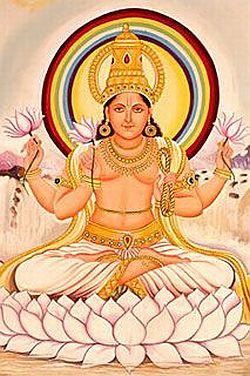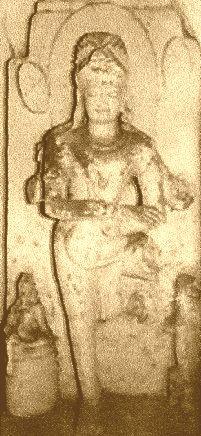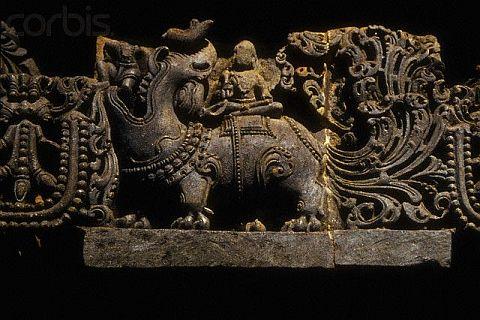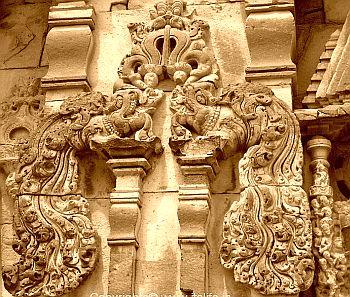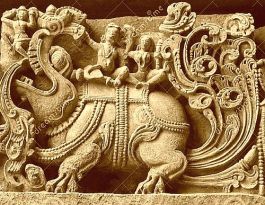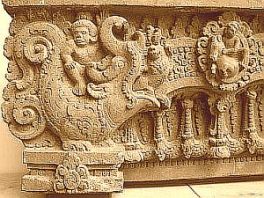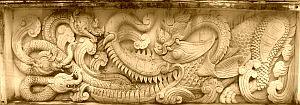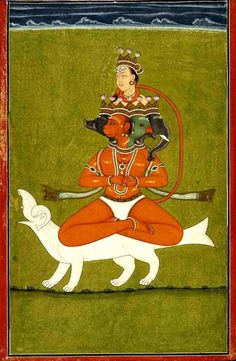
| VARUN, VED AND ZOROASTRIANISM Chapter - 6
V. Varun Iconography :
70.1. The Iconography of Varun is highly varied. The variations are generally two-fold. One, the depiction of his image depends upon the stage of his career at which he is being discussed. For instance, in the context of the early Rig Ved Varun is a sublime, gracious and a very handsome deity who is the lord of all existence. But, in the Brahmanas he is depicted as a severe looking stern judge holding the punitive noose and riding a fearsome mythical monster Makara. And again, when he is portrayed as a water-god the attributes symbolizing water element are stressed; and, when he is shown as Dikpala the guardian of the west he is shown in the air riding his mount in the sky; and so on.
And the other is that the various texts of Shilp Shastra and the Purans each project its own version of Varun image; and, they differ in details.
Thus the Iconography of Varun is not uniform; it is spread across a whole spectrum of varied notions of Varun. In the iconographic sense there is not one but several Varuns. It might not therefore be possible to discuss the whole range of Varun features. We may pick up just a few instances.
70.1. Before looking at few instances of his form, let’s glance at his features in a summary fashion by putting together his descriptions scattered across several texts.
71.1. Most of the descriptions of Varun celebrate him as the lord of the waters; and some (e.g. Aparajita pruccha) hail him as the lord of the west. But, his original attributes, mentioned in Rig Ved, of being the lord of the sky or the governor of Rta are not stressed in the texts dealing with his Iconography. They are completely glossed over. That is understandable, because the Shilpa texts and the Purans are far removed in time from the age of the Rig Ved; and these texts came into being centuries after the Vedic period. By then, Varun’s decline and his demotion into a mere water-god had been complete.
: – Varun is shown either in standing posture (sthanak) or as seated (asan) or as riding his vahan. But he is not shown in reclining position (shayana). He is shown either alone (kevala) or with his consort/s.
:-The Varun – iconography sometimes describes him as having four heads (Vishnudharmottara) and four arms (in Rupamandana, Vishnudharmottara and Aparajita pruccha) ; but, generally he is described with one head and two or four arms.
: – Varun is usually presented as a bright looking, well built god of peaceful and benign disposition. But he is also shown with a potbelly (a characteristic of lunar gods) . The Brahmana texts show him as an obscure (jambaka) ugly looking, white-spotted (shukla), a rather deformed bald headed fat man with protruding teeth (vikidha) and yellow or brownish eyes (pingaksha).
:- His complexion too varies across the texts. In most of the texts he is described as of fair complexion radiant like a conch or a sparkling crystal (spatika). But he is also described as having glossy sky-blue complexion (Rig Ved, Vishnudharmottara); or lustrous golden complexion (Kashyapa shilpa), or dark complexion (Padma samhitha).
:-
Varun usually favours white colour; his garments, ornaments, garlands
and necklaces are of white. But, in some instances he is adorned
in red garments (kashyapa shilpa) or yellow garments (Shilparatna).
: – The Ayudhas or the objects he holds usually are: the pasa (noose), lotus, a jewel box, and a snake. At times he is depicted with water pot (kamandalu) or a mace (musala) or a conch (shankh).
: – Varun’s abode as mentioned in the early Vedic texts is the atmosphere. In the later texts, his abode is in the waters or a region in the ocean (pastatsu) in a multi-pillared mansion. He is also said to have palaces in hilly regions near the Meru on the Pushpagiri hills. Mahabharata mentions that Varuni (also called as Gauri), Vriddhi and Jesta (daughter of Shuklacharya) are his queens. He rides across the heavens in his glittering chariot. He has at his service thousands of spies who report to him on all that the men do or do not do.
Particulars of Varun Iconography as in :
Rig Ved
72.1. Rig Ved describes Varun’s appearance in glowing terms: as the most resplendent god of glowing- sky-blue complexion, with Agni in his face and Surya in his eye. He is far sighted (uru-chaksasa). He is the eye of all the worlds (jagath-chakshu- RV.1.25.5). He has soft and beautiful hands (supani) in which he holds lotuses and an auspicious noose . He is splendidly adorned in golden mantel (drapi) and a shining robe. His chariot dazzles brilliantly like sunrays (ghabasti suro nadyauth – RV.1.122.15).Varun and Mitra ride the golden chariot like floating clouds in the blue sky, drawn by well yoked steeds. (RV.5.62.7). in the midst of vast heavens urukshaya (RV. 1.2.9) he is seated on a splendid throne placed in his golden palace of thousand pavilions, thousand columns (RV. 2.41.5) and thousand doors (RV. 7.88.5). From his glittering throne, the monarch (samrajnya) watches over the deeds of all men and gods (pastyasu) – (RV .1.22.11-12).
Brahmanas
72.2. Taittereya Brahmana (3.9.15.3) and Shatapatha Brahmana (13.3.6.5) present a totally different and a fierce picture of Varun. He is ugly and deformed. He appears here as an obscure figure (jambaka) , as a white-spotted(shukla) bald headed fat man, with protruding teeth(vikidha) and reddish brown eyes (pingaksha).But, he is embellished in golden ornaments.
Purans
72. 3 .1. The sixth century –text Vishnudharmottara Puran (part three, Ch.52, verses 1-21) as also Brihatsamhita carry almost identical descriptions of Varun. In the Vishunudharmottara, sage Markandeya explains that the image of Varun the lord of waters should be made on a chariot with seven swans.
Elsewhere it is said; His colour resembles the glossy brilliant blue (lapis-lazuli). His blue is described as the colour of clear blue sky reflected in a tranquil pool of transparent water. Varun is depicted with four faces, a slightly prominent belly and four arms holding in his: upper right hand – a noose, upper left hand – a conch, lower left hand a – jewel box, and in his lower right hand a lotus.
72.3.2. As per the Varun Dhyana sloka, Varun is smiling, gentle colour of snow, lotus or moon. Varun is wearing white garment; and is well adorned with ornaments and rows of pearl necklaces .He is seated on a magnificent throne along with his two queens (Ganga and Yamuna) . A white umbrella named Abhoga mounted atop the throne is spread over his head. Incidentally, that white umbrella emerged from churning of the ocean and was given to Varun. White umbrella (sveta chattra) is a royal insignia. His emblem Makara the mythical creature is placed to his left. Varun, in most cases is depicted as a highly respected king.
72.3.3. In the Matsya Puran (26.17.18) Varun is depicted as a mighty (maha-balam) god of peaceful continence. He has two arms; and he holds the Pasa; and, gestures assurance (abhaya) or blessings. He is fair in complexion; and glows like a conch (shankha) or the crystal (spatika). He is adorned in white garments, ornaments of pearl, white flower garlands, rows of pearl necklaces and an ornate crown. He is riding a dog or a Makara with dog’s head (basha asana).
Again , Matsya Puran (174.15) sketches Varun as standing in the midst of army of gods, holding a noose and waiting for the fight to commence, like an ocean furious to overshoot the shores.
At another place, Matsya Puran (260.17.18) describes Varun of white complexion like that of a conch and crystal (spatika). His disposition is peaceful. He is adorned with white garlands and garments. He is seated on a Makara or crocodile wearing a crown.
Texts of Shilpa Shastra :
Similar descriptions of Varun are provided in the texts of the Shilp Shastra.
72.4.1. Rupamandana (2.35) describes Varun the regent of the west as having four arms. In three of his hands he holds a Pasa (noose), a lotus and a jewel box (lower left hand). And, his lower right hand is bestowing blessings on the devote. He is riding a crocodile (nakra –arudam).
72. 4.2. Pushkara samhitha (4.153) describes Varun as the lord of waters who is strong and well built (bhimam). His complexion glows like a fresh pearl (muktha-phala dyuthi samam). He is ever surrounded by thousands of Naga nymphs (naga kanya sahasradyam). He rides a Makara.
72.4.3. In contrast to that, Padma Samhita (22.60) and Haya shirsha Samhitha (Adi.25.8) present Varun as dark complexioned (Varunm shyamalam). Of his two hands he holds in the left a noose (pasa) and with his right he gestures assurance (abhaya pradam) and blessings. He is resplendent with his sparkling earrings in the shape of Makara (makara kundala) and in his bright crown modest sized crown (karandi makuta).
72.4.4. In Kashyapa shilpa shastra (48.52.-54) Varun the lord of waters is adorned in red garments (raktha dharo bhushitam); his body is lustrous as gold (swarna varni). In his two hands he holds a snake (naga) and a noose (pasa) .He rides a Makara with his consort Padmini Devi.
72.4.5. Shilpa -ratna gives a slightly different version of Varun. Here the benign (saumyam) and peaceful (shantam) looking mighty (maha balam) is resplendent and fair (swetha varnasthu). He is wearing yellow garments (pitha vastra dharam); and is richly ornamented (sarva-bharana bhushitam) and is adorned with a crown (karandi makuta). He holds a noose (pasa) in each of his two hands; and is riding a Makara. . He is placed in a yajna pavilion (yajna satra).
72.4.6. In Aparajita pruccha (213.13) Varun the regent of the west is described with four arms. He holds in his upper right arm a pasa (noose), in his upper left a lotus or a nag, in the lower left a water pot (kamandalu) and with his lower right he bestows assurance and blessings (varam).He rides a Makara.
72.4.6. Hayastra Pancharatra depicts Varun as a water-god; he is shown with two arms standing on back of a swan. His right hand shows gesture of removing fear (abhaya).In his left hand he holds a noose made of a snake. The water pot is to his left. He is accompanied by his consort Vriddhi on the left and his son Pushkar on the right. He is surrounded by serpents, rivers, and water animals.
There are of course no temples dedicated to Varun. But, his image is at times carved in the niche of the western temple walls. Let’s see a few such instances.
73.1. In the eleventh century Brahmeshwar temple, Bhubaneswar Orissa , an image of Varun is carved in the niche on its western wall . Varun is depicted as standing (sthanaka) in a relaxed and graceful posture holding in his right hand a long noose by its end while his left hand is placed on his hip. In his lower left hand he holds a water vessel. He is adorned with jewelled crown,( ratna-kundala,) pearl yajnopavitha that runs down across his chest, , and with a waist girdle. An oval halo is carved around his head. At his feet lies the Makara with its mouth open standing in the waters. His consorts carved at the base in miniature figures carry lotuses.
73.2. In the Raja-rani temple at Bhubaneswar, Varun two armed is standing near Makara. He holds a noose in his left hand. And his right hand shows gesture of removing fear (abhaya)a noose (pasa) by its end in the left. Makara is depicted next to him. This sculpture is remarkable for its relaxed demeanour, pleasant facial expression and rich ornamentation.
73.4. In the Kosalesvara temple (c. eighth century) at Patnagarh, Orissa, an exquisitely carved image of a youthful Varun sitting in a relaxed pose (lalithasana) is on the temple wall on the west. He is richly ornamented with a beautiful crown bearing a kirtimukha logo at its centre, a semi oval Prabhavali (orb ) placed behind his head, rows of necklaces (Hara, Keyura, Kankana, Katisutra) and an yajnopavitha across his chest.
73.5. Varun is often depicted along with a waterfowl as in the following.
73.6. A seated figure of Varun is carved on the walls of the Parasuramesvara temple, Orissa, (c.10tcentury). Varun is on the lower left.
73.7. The tenth-eleventh century temple of Banteay Srei, Cambodia, displays rich and varied depictions of Varun as riding a swan or a Makara; and surrounded by host of followers.
74.1. Makara is often translated as crocodile. In the context of Indian iconography that may not be quite correct. Makara as referred to here is truly a mythical creature that combines in itself the features of several sea and land animals. Makara has no well defined form or structure. Its appearance varies depending on the features of the animals that combine into its form. Perhaps because of its indefinite form, Makara is termed a monster in the sense that it is neither this nor that. It is a mythical beast of both land and sea with fanciful features. Almost any weird combination of animals could be a Makara. But the two common features of all Makara forms are: a long and a probing snout; and the other, an elaborate and spread out tail.
75.1. In the Indian Iconography , Makara is a composite figure, generally, with a trunk as that of an elephant, ears like that of a cow, eyes as those of a fish, body as that of a boar, and the tail elaborate and bushy like that of a peacock ; and its legs resemble that of a lion . It could even be presented as fantastic marine monster structured with the body and tail of a fish and the forelegs, neck, and head of an antelope, an alligator, or a shark; or whatever.
75.2. It is also called kantaka, Asita-dramstra (black teeth) and jala-rupa (water form). Makara may be shown either as carrying a rider on its back (vahaka yuktam) or it may not (svatantram). It may even be shown as if it is ready to pounce and attack (yuddha sannaddham) or just being playful (kridabhi-ramakam).
75.3. A feature of Indian temple architecture is Makara –Torana the ornamental arch way to the temple entrance; it also adores the doorway to the sanctum. Makara toranas are very varied with endless permutations of elaborate patterns and designs. But, invariably the toranas are artfully designed to suggest as if the doorway is held afloat, at either end, by the extended snouts of two Makars with frothy or bushy peacock tails. Even the Buddhist monuments including the gateway to the ancient Sanchi stupa are decorated by Makara toranas.
75.4. Sometimes, when it is used as a decorative motif its entire body may not be depicted; but, only its head could be detailed along with its tail either well spread out and standing up (puchcham urdhva visrtam) or spread around (sarvato gatam) or hanging down to earth (bhu-pranta vikshiptam).
75.5. Makara’s face alone is used in Indian temple architectural element as kirtimukha “glory face”.
75.6. Makara as a decorative and as a royal insignia is well accepted. It is a widely used decorative embellishment and a symbol in most Indian works of art and in iconography.
Makara – an Indian symbol that travelled worldwide :
76.1. Makara is essentially an Indian symbol. It is very ancient too. In the Bhagavad-Gita Sri Krishna mentions “I am Makara among the aquatics (jhasanam makarah) just as the Ganga among the rivers and Rama among the warriors”- (Gita .10.31). As a sea creature, Makara may have initially been a fish or a crocodile but later on it took many fanciful forms.And, it spread to to the Far East to Combodia etc.
The Makara concept seems to have captured the imagination of rest of the ancient world too. Makara in its various forms and manifestations spread to west . And it is said, Makara‘s metamorphosis is the Babylonian water-god Ea an antelope-fish; the goat-fish Capricorn of the Zodiac; the horse-headed sea-water animal or water-serpent Nykkur of Norse legends; and, the mythical seahorse and the dragon. Even the Sphinx could be termed a Makara. It is also explained that in old-Greek Makara means ‘the blessed ‘and is root of Greek names such as Makarios.
76.2. The combination of the features of an aquatic animal, a serpent, an elephant and the dragon; as also the mystic symbolisms associated with it inspired the legends, myths and all art forms in Burma, China , Far East and in Buddhism. It is also said; the ancient flag of ancient seafaring people of Sri Lanka, the Karware carried the Makara emblem with an image of a fish at its centre. Burma’s animal of five beauties is also a Makara.
Makara Symbolism :
77.1. Makara is rich in symbolism. Ananda K Coomaraswamy (in his Yaksha) writes “Makara is a great Leviathan (serpent) moving through the primeval waters, the cosmic ocean of the night sky, which contain the essence of life.” He suggests, Makara stands for Prakrti that manifests the un-manifest. He equates Makara with the abode of lotus which in turn symbolizes life.
77.2. In the Indian calendar , Makara –Sankranthi (in December/ January) marks the end of winter solstice and the entering of the Sun into the tenth house of the Zodiac heading toward the northern hemisphere. It is the dawn for the gods. It also is the birth of time; and the first day of the New Year. Makara is associated with creation-process; thus, it symbolizes time and its cyclic nature. Makara is therefore prominently placed in Sun temples.
77.3. The Makara, its forms and symbolisms have permeated Indian art and living at various levels. Apart from being a royal insignia and serving as a decorative designer as a structural bracket, Makara is the vahana, the vehicle or the ride, of Varun, the goddesses Lakshmi, Ganga and Saraswathi; and, is the banner on Kamadeva’s flag. The earrings of Vishnu and other gods are in the shape of Makara (Makara-kundala).In astrology Makara is related to constellation of Capricorn (Makara-raasi) with Sea-Goat as its symbol.
There is even a depiction of the five-faced Hanuman riding a Makara :
Five Faced Hanuman 77.4. The elephant-like trunk of the Makara and the waters bring together Lakshmi goddess of beauty and prosperity and Ganga the river goddess. Elephants are associated with clouds, rains and waters. Makara which serves Lakshmi, Ganga and other river-goddesses as their vahana, the ride, is also connected with water.
References and Sources :
1. Indra and Varuna in Indian Mythology by Dr. UshChoudhuri; Nag Publishers, Delhi, 1981
2. The Indian Theogony by Dr.Sukumari Bhattarcharji, Cambridge University Press, 1970
3. Asura in early Vedic religion by WE Hale; Motilal Banarsidass; Delhi, 1986
4. Goddesses in ancient India by PK Agrawala; Abhinav Publications, New Delhi,1984
5. The Hymns of Atharvan Zarathustra by JM Chatterji; the Parsi Zoroastrian Association, Calcutta, 1967
avesta.org
6. Outlines of Indian Philosophy –Prof M Hiriyanna; Motilal Banarsidass, Delhi, 2005
7.Original Sanskrit texts on the 0rigin and history of the people of India, their region and institution By J. Muir;Trubner & co., London, 1870.
8. A classical dictionary of Hindu mythology and religion, geography, history, and literature byJohn Dowson; Turner & co, Ludgate hill. 1879.
9. Vaidika Sahitya Charitre by Dr. NS Anantharangachar; DVK Murthy, Mysore, 1968
10. Sri Brahmiya Chitra Karma sastram by Dr. G. Gnanananda
11. Zarathustra Chapters 1-6 by Ardeshir Mehta; February 1999
Websites :
indiayogi.com
bookrags.com
bookrags.com
hinduweb.org
rashmun.sulekha.com
newworldencyclopedia.org
indiadivine.org
svabhinava.org
en.wikipedia.org
iamronen.com |
